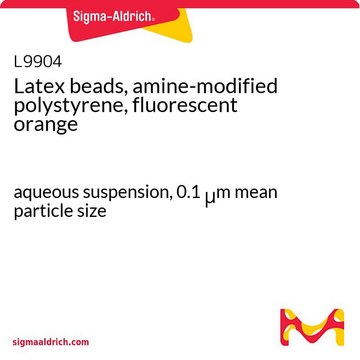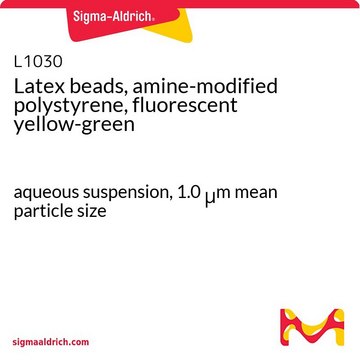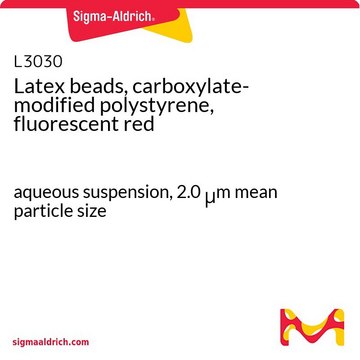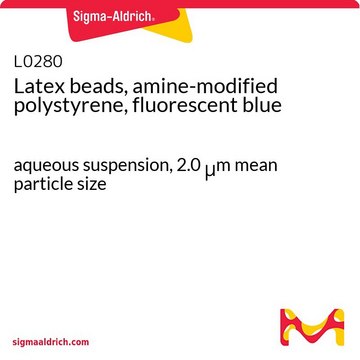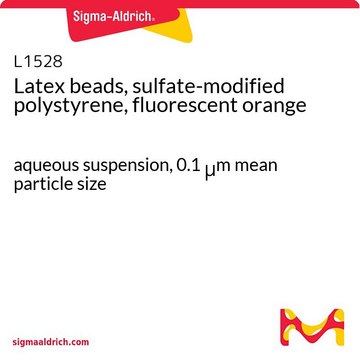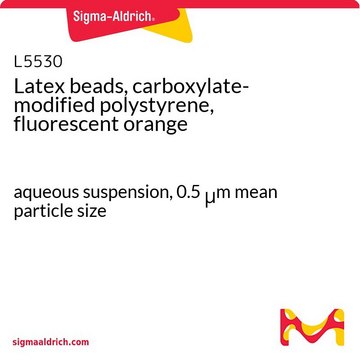L0780
Latex beads, amine-modified polystyrene, fluorescent blue
aqueous suspension, 0.05 μm mean particle size
Se connecterpour consulter vos tarifs contractuels et ceux de votre entreprise/organisme
About This Item
Produits recommandés
Forme
aqueous suspension
Niveau de qualité
Composition
Solids, 2.5%
Technique(s)
cell based assay: suitable
Taille moyenne des particules
0.05 μm
Fluorescence
λex ~360 nm; λem ~420 nm
Application(s)
cell analysis
Vous recherchez des produits similaires ? Visite Guide de comparaison des produits
Application
Latex beads, amine-modified polystyrene, fluorescent blue has been used:
- to study its effects on the concentration-response relationship of bacterial cell viability
- in the preparation of nanoparticles
- as a model nanoparticle to study interactions with human blood and platelets
Actions biochimiques/physiologiques
Polystyrene latex beads can be used to create latex agglutination systems. Polystyrene latex beads have been used to study the transmission of Mycobacterium leprae, the causative pathogen of leprosy, as well as to develop a method for mass screening for both pulmonary and extrapulmonary tuberculosis.
Code de la classe de stockage
10 - Combustible liquids
Classe de danger pour l'eau (WGK)
WGK 3
Point d'éclair (°F)
Not applicable
Point d'éclair (°C)
Not applicable
Faites votre choix parmi les versions les plus récentes :
Déjà en possession de ce produit ?
Retrouvez la documentation relative aux produits que vous avez récemment achetés dans la Bibliothèque de documents.
Les clients ont également consulté
J-M Gineste et al.
Journal of microscopy, 243(2), 172-178 (2011-03-08)
The forward scattering of light in a conventional inverted optical microscope by nanoparticles ranging in diameter from 10 to 50nm has been used to automatically and quantitatively identify and track their location in three-dimensions with a temporal resolution of 200ms.
Optical signatures of small nanoparticles in a conventional microscope.
Eann A Patterson et al.
Small (Weinheim an der Bergstrasse, Germany), 4(10), 1703-1706 (2008-09-10)
INDUCTION OF EPIGENETIC RESPONSE TO AMINO-MODIFIED POLYSTYRENE NANOPARTICLES IN HUMAN CELLS
Koprinarova M, et al.
Comparative clinical pathology, 71(10) (2018)
Catherine McGuinnes et al.
Toxicological sciences : an official journal of the Society of Toxicology, 119(2), 359-368 (2010-12-03)
There is evidence that nanoparticles (NP) can enter the bloodstream following deposition in the lungs, where they may interact with platelets. Polystyrene latex nanoparticles (PLNP) of the same size but with different surface charge-unmodified (umPLNP), aminated (aPLNP), and carboxylated (cPLNP)-were
J Geys et al.
Toxicology letters, 160(3), 218-226 (2005-09-03)
Recent studies indicate that inhaled ultrafine particles can pass into the circulation. To study this translocation in an in vitro model three types of pulmonary epithelial cells were examined. The integrity of the cell monolayer was verified by measuring the
Notre équipe de scientifiques dispose d'une expérience dans tous les secteurs de la recherche, notamment en sciences de la vie, science des matériaux, synthèse chimique, chromatographie, analyse et dans de nombreux autres domaines..
Contacter notre Service technique
